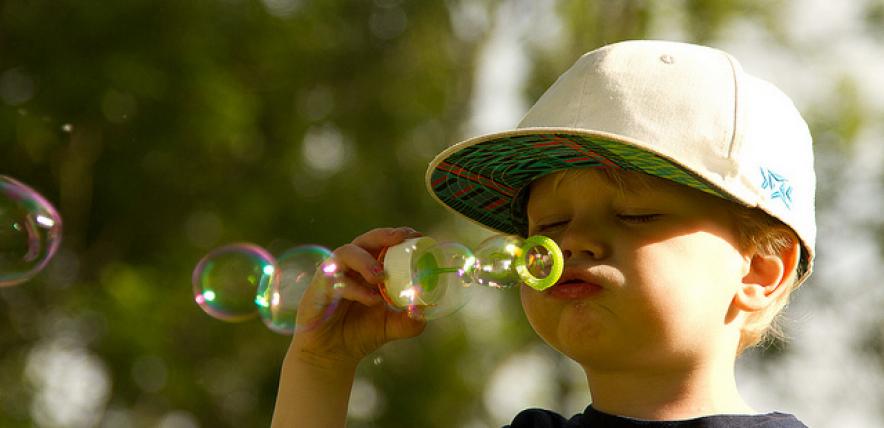Bubbles are a simple, cheap and effective resource for you and your child to explore and have fun with.
There are a multitude of learning opportunities at your fingertips whenever you reach for the bubble solution, and it is a resource that can be adapted for whatever age and stage your child is at.
A bubble bath and washing up suds are easy ways to introduce the concept of bubbles to your child, but most children will be more likely to be instantly inspired by bubbles of the floating and popping kind.
If you don’t have any luck with off-the-shelf bubble mixture, you can make your own.
For bubble play to enchant and educate, it helps if the bubbles last more than a second or two before popping.
According to the Science Museum, the secret ingredient for the perfect bubble mixture is glycerin. Mix up 95% water with 3% washing up liquid and 2% glycerin for bubbles that are stronger and last longer.
Babies
For babies under six months, bubbles will be a sensory experience: watching the bubbles floating, attempting to grab them, and perhaps experiencing the feeling of bubbles bursting on their skin. Older babies may enjoy being helped to hold a bubble wand and wave it through the air to see the bubbles appear, or to investigate any bubbles that have landed near them.
Toddlers
Most toddlers (18 months to 3 years) love to chase and burst floating bubbles, and it’s when your child is a little older that the learning opportunities really begin to present themselves.
Show your child how to blow bubbles, then take it in turns to blow and pop the bubbles.
This simple activity in itself is a powerful learning tool, developing fine motor skills through grasping, dipping and holding the wand steady as well as gross motor skills when running, stretching, jumping, stamping and grabbing the floating bubbles.
Blowing through the wand strengthens mouth and lip muscles which are important for developing speech and language, and also helps improve hand-eye coordination.
Dealing with the different sensations involved in blowing and catching bubbles is also a learning experience for young children discovering how the world looks and feels. Turn taking requires communication and social skills too, so there is a lot of learning going on in this one simple activity.
Pre-schoolers
When adapting bubble-blowing activities for older pre-schoolers (four and five years) in order to expand their enjoyment and learning, remember that the possibilities are virtually limitless.
Get them to help you look around at home and see what you have which could be used as a bubble wand. Perhaps a slotted spoon, a wire coat hanger and a few pipe cleaners twisted into different shapes might be a good start.
Allow your child to experiment by themselves giving them experience of problem solving and decision making. Once they tire of self-directed play, try giving more specific instructions for the bubble catching activity such as ‘pop the bubbles only with your left hand’ (or feet or knee or thumb for example), or change the method of popping – poke, grab, stamp, clap.
There are plenty of ways to involve numbers and counting, and talking about the colours and shapes of the bubbles, and where they are positioned, will help enrich your child’s language.
In addition to outdoor bubble chasing, there are lots of creative ways to involve bubbles when playing indoors. Here are a few ideas for inspiration.
- Bubble painting: Mix some different poster paints or food colourings into separate large, shallow containers of bubble solution. Blow into the colourful solution using a straw until the surface is well covered with bubbles then ‘float’ the paper on top, taking care not to dip it into the liquid. Remove carefully and allow to dry before looking at the resulting patterns.
- Ice bubbles: Blow a few bubbles of different sizes and carefully transfer them to a plate. Pop in the freezer for a few minutes and with luck your bubbles will freeze before they pop. Shattering your ice bubbles is incredibly fun!
- Bubble mountain: slosh some solution into a bowl or cup and blow with a straw while watching a mountain of bubbles appear.
Written for the Early Years Alliance by Martha Hales.








